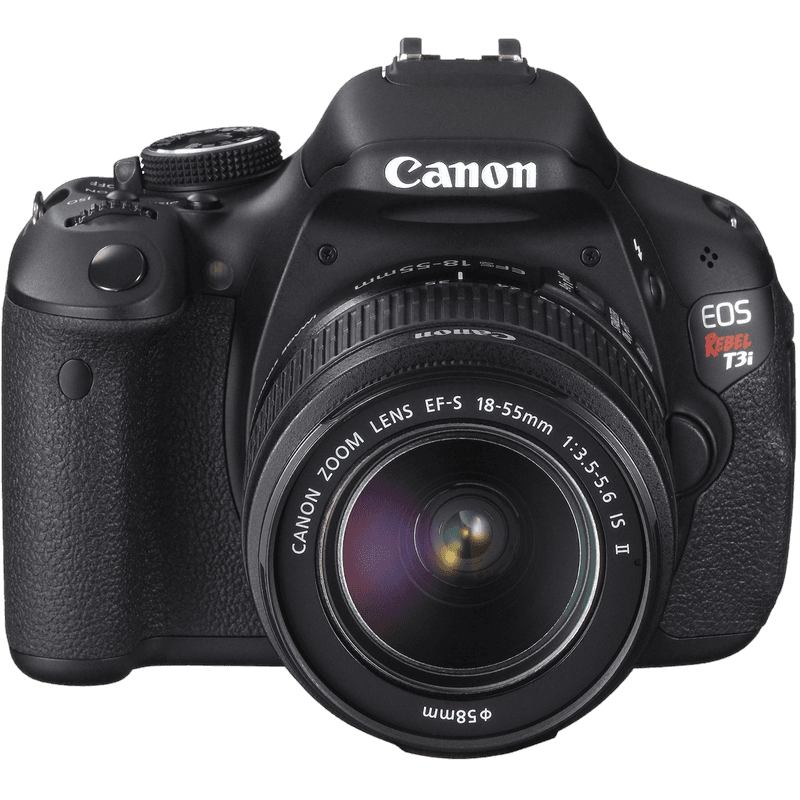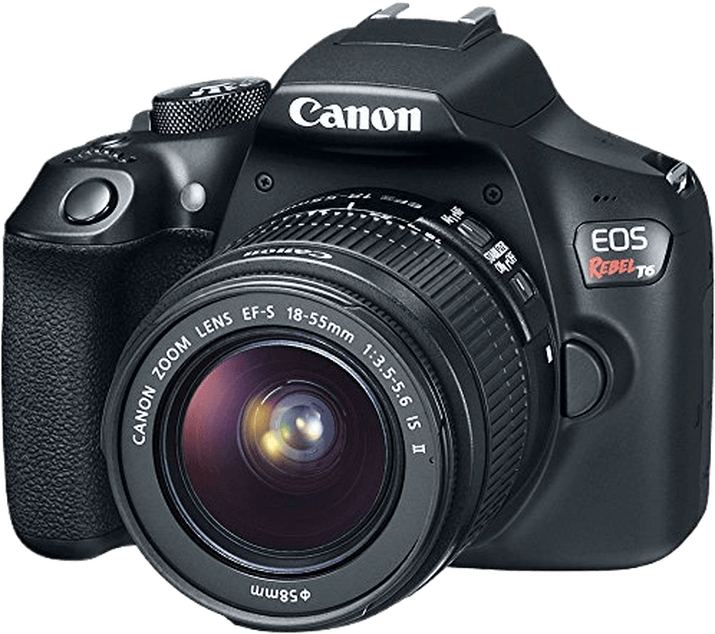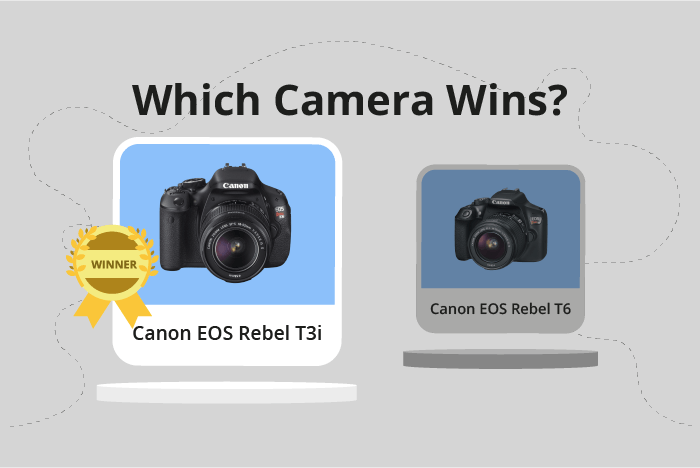Canon EOS Rebel T3i / 600D vs EOS Rebel T6 / 1300D Comparison
Canon EOS Rebel T3i / 600D

Canon EOS Rebel T6 / 1300D

The Canon EOS Rebel T3i (600D) narrowly wins with a score of 40/100, while the Canon EOS Rebel T6 (1300D) follows closely behind at 39/100. Both cameras are DSLR types, sharing common specifications like their announcement and release years, 2011 for the T3i and 2016 for the T6.
The T3i has a slightly larger camera size, measuring 133 x 100 x 80mm, and is heavier at 570g (1.26lbs). This makes it more durable and potentially better suited for professional usage. On the other hand, the T6 is more compact at 129 x 101 x 78mm and lighter, weighing 485g (1.07lbs), which may appeal to casual photographers or those looking for a more portable option.
Considering the price, the T6 launched at a more affordable $550 compared to the T3i’s $850. This makes the T6 a better choice for budget-conscious buyers, while the T3i may be preferred by those who prioritize durability and professional use.
Canon EOS Rebel T3i / 600D vs EOS Rebel T6 / 1300D Overview and Optics
The Canon EOS Rebel T3i / 600D and the Canon EOS Rebel T6 / 1300D both score 40/100 in optics, indicating no clear winner in this category. They share several specifications, including 18 megapixels, CMOS sensor type, APS-C sensor size, Canon EF-S lens mount, and no image stabilization.
The T3i / 600D has a slight advantage in shooting speed, offering 3.7 frames per second (fps) compared to the T6 / 1300D’s 3 fps. This means the T3i / 600D is better for capturing fast-moving subjects or shooting in continuous mode.
On the other hand, the T6 / 1300D has a marginally better DXOMARK score for the sensor, with a score of 66 compared to the T3i / 600D’s score of 65. This shows that the T6 / 1300D has a slightly better sensor performance. Additionally, the T6 / 1300D features a more advanced processor, the Digic 4+, while the T3i / 600D uses the older Digic 4 processor. This results in the T6 / 1300D having a better overall image processing capability.
Despite the minor differences in shooting speed, sensor performance, and processor, both cameras have the same optics score. The T3i / 600D is better suited for capturing fast-paced action, while the T6 / 1300D has a slight edge in image quality and processing. Ultimately, the choice between these two cameras depends on the user’s priorities and preferences.
Canon EOS Rebel T3i / 600D vs EOS Rebel T6 / 1300D Video Performance
The Canon EOS Rebel T3i/600D and the Canon EOS Rebel T6/1300D share the same video score of 43/100. Both cameras offer Full HD video resolution with maximum dimensions of 1920 x 1080 and a maximum frame rate of 30fps. Neither camera has built-in time-lapse functionality.
The T3i/600D and T6/1300D have several video specifications in common, making it difficult to determine a clear winner based on their video capabilities alone. Both cameras provide users with the ability to capture high-quality video at the same resolution and frame rate. This means that users of either camera can expect similar video performance when it comes to resolution and smoothness of motion in their videos.
Since both cameras have the same video score and share similar specifications, neither camera outperforms the other in terms of video capabilities. However, it is essential to consider other factors, such as price, ease of use, and additional features, when deciding between these two cameras.
In conclusion, the Canon EOS Rebel T3i/600D and the Canon EOS Rebel T6/1300D have identical video scores and share common video specifications. As a result, potential buyers should focus on other factors such as price, ease of use, and additional features when choosing between these two cameras for their video needs.
Canon EOS Rebel T3i / 600D vs EOS Rebel T6 / 1300D Features and Benefits
The Canon EOS Rebel T3i / 600D emerges as the winner in the features comparison, with a score of 44/100, compared to the Canon EOS Rebel T6 / 1300D’s score of 41/100. Both cameras share several specifications, such as screen size, flip screen, and lack of GPS and Bluetooth capabilities. However, there are differences that set them apart.
The T3i / 600D has a higher screen resolution of 1,040,000 dots compared to the T6 / 1300D’s 920,000 dots. This difference means the T3i / 600D provides a clearer and more detailed image when reviewing photos on the camera’s LCD screen. The higher resolution is a significant advantage for the T3i / 600D, as it allows for better image preview and easier menu navigation.
On the other hand, the T6 / 1300D has the advantage of built-in Wi-Fi, which the T3i / 600D lacks. This feature allows the T6 / 1300D to wirelessly connect to compatible devices for easy photo sharing and remote control capabilities. While this may not be a critical feature for some users, it certainly adds to the convenience and versatility of the camera.
Taking these points into consideration, the T3i / 600D’s superior screen resolution makes it the better choice for those who prioritize image quality and clarity on the camera’s display. However, if wireless connectivity is a priority, the T6 / 1300D’s Wi-Fi capability could be the deciding factor. Ultimately, the choice between these two cameras will depend on the specific needs and preferences of the user.
Canon EOS Rebel T3i / 600D vs EOS Rebel T6 / 1300D Storage and Battery
The Canon EOS Rebel T6 / 1300D wins in storage and battery with a score of 27/100, compared to the Canon EOS Rebel T3i / 600D’s score of 24/100. Both cameras share common specifications, such as having one memory card slot and accepting SD, SDHC, and SDXC memory cards. Neither camera supports USB charging.
The T6 / 1300D outperforms the T3i / 600D in battery life, providing 500 shots per charge, while the T3i / 600D only offers 440 shots. The T6 / 1300D uses the LP-E10 battery type, whereas the T3i / 600D uses the LP-E8 battery type. The T3i / 600D does not have any advantages in storage and battery over the T6 / 1300D.
Considering these points, the T6 / 1300D is the better choice for those prioritizing longer battery life.
Alternatives to the Canon EOS Rebel T3i / 600D and EOS Rebel T6 / 1300D
Are you still undecided about which camera is right for you? Have a look at these popular comparisons that feature the Canon EOS Rebel T3i / 600D or the Canon EOS Rebel T6 / 1300D:

